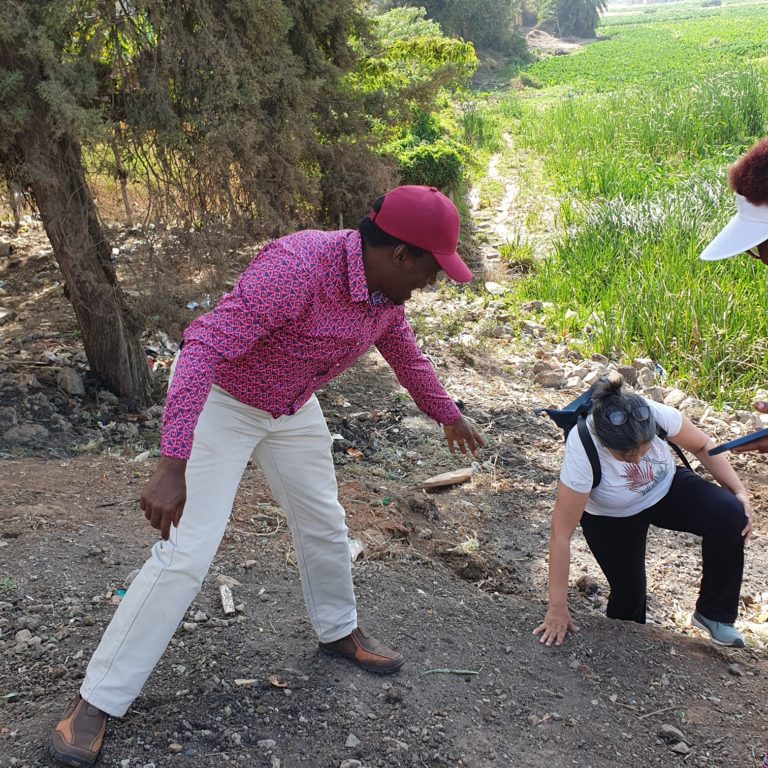This blog post is written by Aleksandra Arent at the MSc course Act Local, Think Global.

Landscape Architects faces many challenges. Photo: Emily Wade
Food security is one of the most pressing issues of our time. In Kibera, an informal settlement in Nairobi, some people spend even 80% of their income on imported food, some eat meals provided by the NGOs operating within the settlement, and others engage in the practices of local urban agriculture. The dominating practices are growing kale in sacks, corn in unbuilt spaces and cultivating arrow root directly in the Nairobi Dam which comes with many health hazards (Gallaher et al., 2013). The water in Nairobi Dam is highly polluted and deemed unsuitable for human and animal consumption (Mandela, 2016). However, due to the unavailability of good quality local farmland accessible to the urban poor, the people of Kibera are forced to consume the toxic aro roots. Yet, just North of the settlement there lies a vast, irrigated Royal Golf Club sized around 80 ha containing grass monocultures and patches of woodland. The golf course is one of the sites left from the era of British colonialism and bears the symbolism of the extreme social inequalities persisting since that period, which drive the internal and cross-border migrations today.
Kibera has a constant inflow of inhabitants, fleeing from the rural areas in search of better employment opportunities in Nairobi. Currently, it has around 800 000 dwellers and is one of 200 informal settlements hosting a total of about 2 500 000 people within the capital, which makes up 60% of the city’s population. The question arises: why do people in Kenya leave their rural dwellings to live in these dense settlements with very low access to food and barely any land available for cultivation? What drives food insecurity in the rural parts of the country? Following Walden Bello (2009), one of the answers lies in the structural adjustment programme in the 1980s encouraged by the World Bank and incorporated into policy-making in exchange for 1 billion USD of loans given to various African countries (Federici and Achebe, 2001). This has led to the dismantling of state support for farming and the inadequate takeover of public institutions by the private sector. That ultimately enhanced the favouritism of commercial large-scale food producers leaving smallholders with no means of support. Bello also underlined the disadvantageous export rates to the EU and the USA, making the African farmers deprived of public subsidies to compete with European and US markets with their food prices paradoxically lowered by governmental financial support. The threat of food insecurity and financial ruin of the African smallholder farmers is partially linked to the prioritisation of production for export to finance the ever-growing foreign debts. Finally, the World Bank’s vision for the development of the continent’s agriculture is a further expansion of corporate agriculture alongside the preservation of traditional practices in ‘reserves’ (Bello, 2009), which will lead to further displacement of rural communities to urban settlements.
From this brief analysis, we arrive back in Kibera and the need for a rethinking of urban agriculture, which is still perceived by the decision-makers as a sign of importing rural backwardness to the cities. Yet, is not a matter of choice in the growing dominance of large-scale export crop monocultures outside the urban areas. The inability of rural landscapes to provide livelihoods to their inhabitants puts even more pressure on rational land use within the cities and making space for efficient and varied local food production. It also emphasises the irrelevance of the 80-ha golf course serving the capitalist elites with its enclosed irrigated vegetation bordering an informal settlement of 800 000 people doomed to eat toxic arrow roots from the Nairobi Dam polluted with sewage, rubbish and pharmaceuticals.
References:
Bello, W. (2009). The Debt Crisis, Africa, and the New Enclosures. In: The Food Wars. Verso.
Federici, S. and Achebe, C. (2001). The Debt crisis, Africa and the new enclosures.
Gallaher, C.M., Kerr, J.M., Njenga, M., Karanja, N.K. and WinklerPrins, A.M.G.A. (2013). Urban agriculture, social capital, and food security in the Kibera slums of Nairobi, Kenya. Agriculture and Human Values, [online] 30(3), pp.389–404. doi:https://doi.org/10.1007/s10460-013-9425-y.
Mandela, O. (2016). Management strategies for restoration of Nairobi Dam. [online]
Available at: http://erepository.uonbi.ac.ke/bitstream/handle/11295/153080/Mandela_Management%20Strategies%20For%20Restoration%20Of%20Nairobi%20Dam.pdf?sequence=1&isAllowed=y.
This blog post is the fourth one in a series of four blog posts from the Master’s course Act Local, Think Global given by SLU and JKUAT Nairobi.
